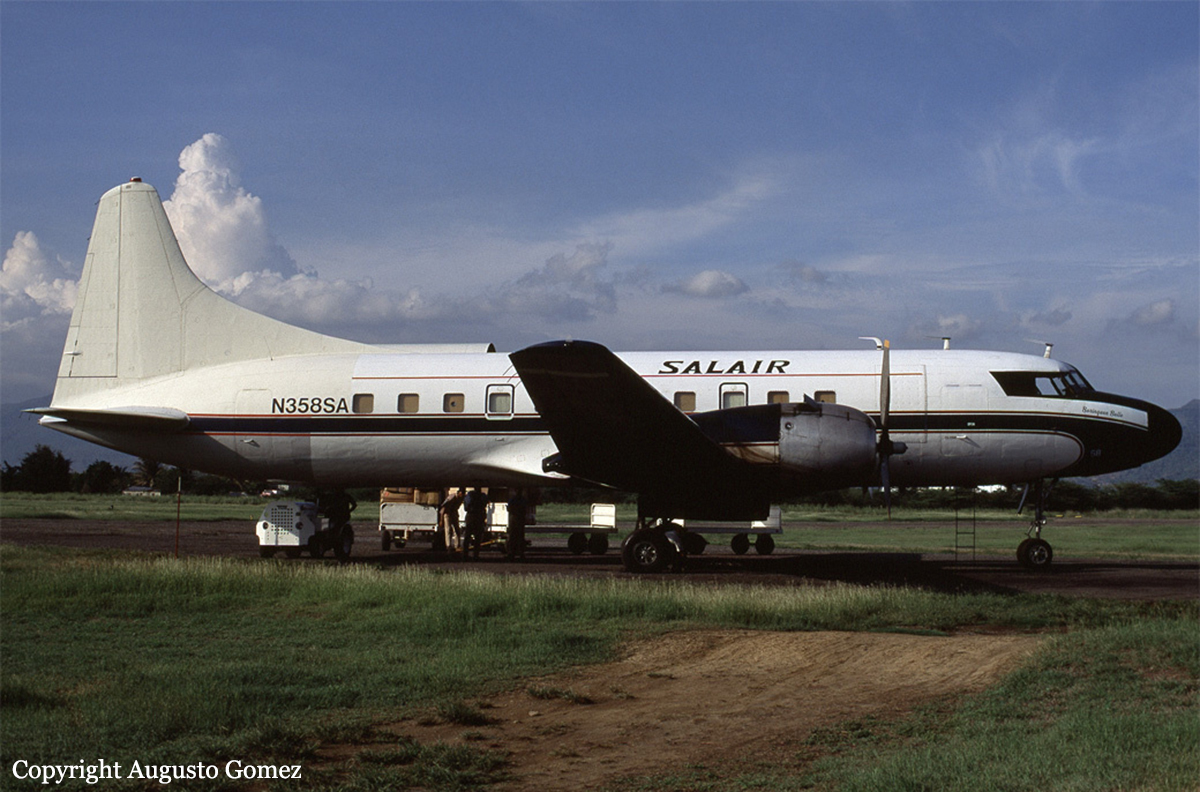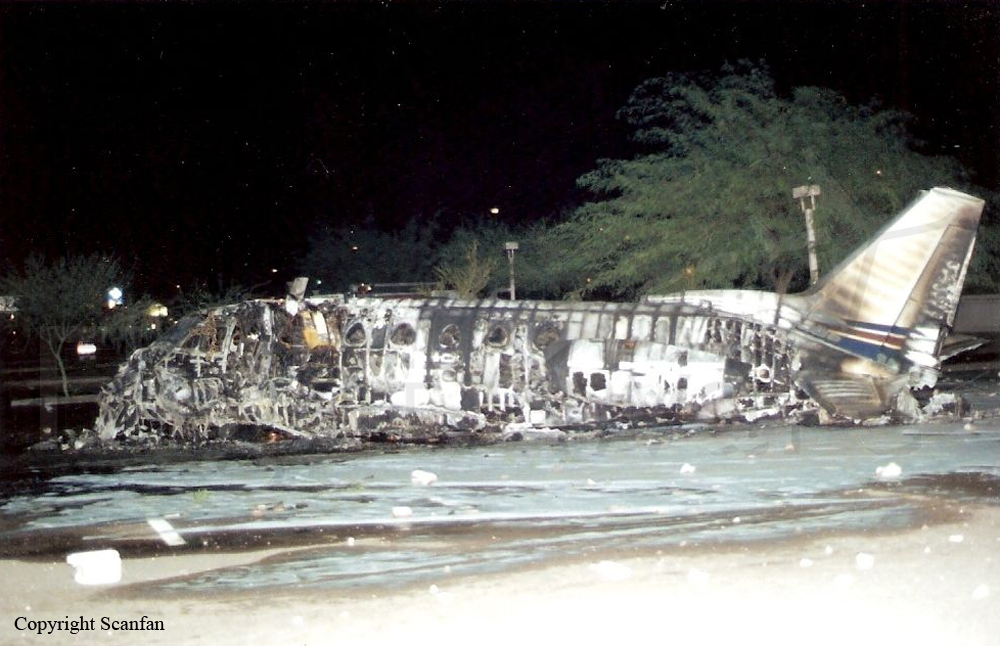Zone
Crash of a Beechcraft E90 King Air in Flagstaff: 3 killed
Date & Time:
Jan 31, 1996 at 1305 LT
Registration:
N300SP
Survivors:
No
Schedule:
Flagstaff - Phoenix
MSN:
LW-166
YOM:
1976
Crew on board:
1
Crew fatalities:
Pax on board:
2
Pax fatalities:
Other fatalities:
Total fatalities:
3
Captain / Total hours on type:
613.00
Aircraft flight hours:
5952
Circumstances:
The pilot and 2 nurses departed IFR to transport a patient from another location. During the initial climb, the pilot observed a gear unsafe light. He requested clearance to an area of VFR conditions to address the gear problem. Subsequently, the gear was manually extended with safe gear indications. The flight department requested that the pilot return to base. The pilot obtained an IFR clearance to return for an ILS approach. After handoff to the tower, he was requested to report the FAF inbound after an eastbound procedure turn. That was the last communication from the pilot. Subsequently, the aircraft crashed on the southeast side of Humphreys Peak at an elevation of about 10,500 feet and about 10 miles west of the final approach course. Wreckage was scattered along a heading of 230 degrees. There was evidence that the airplane was in a steep descent when it crashed. Radar data revealed an outbound track west of the published course and no procedure turn. The weather was IMC with light snow and rain. Moderate to severe turbulence was forecast and confirmed by other pilots. The winds at 10,000 feet were forecast to be 50 knots out of the southwest. Moderate turbulence and light rime ice had been reported along the ILS approach course before to the accident time.
Probable cause:
Failure of the pilot to follow prescribed IFR procedures and his failure to maintain control of the aircraft. Factors relating to the accident were: the adverse weather conditions with icing and turbulence.
Final Report:
Crash of a Convair CV-440F Metropolitan in Spokane
Date & Time:
Jan 4, 1996 at 1853 LT
Registration:
N358SA
Survivors:
Yes
Schedule:
Phoenix - Spokane
MSN:
153
YOM:
1954
Crew on board:
2
Crew fatalities:
Pax on board:
0
Pax fatalities:
Other fatalities:
Total fatalities:
0
Captain / Total hours on type:
817.00
Aircraft flight hours:
8642
Circumstances:
Before the ferry flight, the pilot (PIC) & inexperienced copilot noted the left & right, float-type, underwing, fuel gauges indicated about 3,900 & 4,050 lbs of fuel, respectively. After takeoff, they noted that the cockpit gauges showed an opposite fuel imbalance of 4,100 & 3,600 lbs in the left & right tanks. Due to this indication, the PIC crossfed fuel from the left tank to both engines for about 30 min to rectify the perceived fuel imbalance. Later as they approached the destination, the left tank was exhausted of fuel, & the left engine lost power, although the left gauge indicated about 500 lbs of fuel remaining in that tank. The PIC then crossfed fuel from the right tank to both engines, & left engine power was restored. ATC vectored the flight for an emergency ILS runway 3 approach. The PIC was distracted during the approach & maneuvered the airplane to re-intercept the localizer. About 500' agl in IMC, both engines lost power. During a forced landing at night, the airplane struck a raised berm & was damaged. No evidence of fuel was found in the left tank; 125 gal of fuel was found in the right tank. Unusable fuel was published as 3 gal. During an exam of the engines & fuel system components, no preimpact failure was found. Historical data from the manufacturer indicated that when the airplane had a low fuel state, unporting of fuel tank outlets could occur during certain maneuvers. This information was not in the Convair 340 flight manual, although unporting of the outlets on this flight was not verified.
Probable cause:
The pilot's improper management of the fuel/system, which resulted in loss of power in both engines, due to fuel starvation. Factors relating to the accident were: false indications of the cockpit fuel gauges, darkness, and the presence of a berm in the emergency landing area.
Final Report:


Crash of a Cessna 208B Super Cargomaster in Flagstaff: 1 killed
Date & Time:
Jan 11, 1995 at 1805 LT
Registration:
N746FE
Survivors:
No
Schedule:
Flagstaff - Phoenix
MSN:
208-0236
YOM:
1990
Flight number:
FDX7551
Crew on board:
1
Crew fatalities:
Pax on board:
0
Pax fatalities:
Other fatalities:
Total fatalities:
1
Captain / Total hours on type:
2000.00
Aircraft flight hours:
2439
Circumstances:
A witness located near the departure end of the runway saw the airplane initially climb in a normal manner, then stay below the clouds and make a shallow bank 180-degree left turn and descend below a tree line. Tower tapes revealed that the pilot twice transmitted that he was "coming back" to the airport during which the background sound of the "fuel selector off" warning horn was heard. The pilot then informed the controller "I've got to get back", and no warning horn was heard. The airplane collided with trees and came to rest about 6,500 feet sse of the runway's end. Prior to departure, the airplane was refueled with 40 gals of jet a (20 gals per tank), which increased the total fuel load to 148 gals. The flight manual required that the fuel balance between the left and right tanks be kept within 200 pounds, and suggested turning off one fuel selector to correct unbalance situations. The condition of one fuel selector turned off will cause the "fuel selector off" warning horn to sound. Exam of the aircraft revealed no evidence of preimpact failures. Prop blade butt signatures indicated it was operating in the governing range, and engine power was being produced at impact.
Probable cause:
The pilot's failure to properly configure the aircraft fuel system prior to takeoff, and his failure maintain an adequate terrain clearance altitude while maneuvering to return to the airport. Factors in the accident were the dark night lighting conditions, low ceilings, restricted visibility conditions, and the pilot's diverted attention which resulted from activation of the airplane's fuel selector warning horn system.
Final Report:
Crash of a Rockwell Sabreliner 60 in Phoenix
Date & Time:
Nov 7, 1992 at 2226 LT
Registration:
N169RF
Survivors:
Yes
Schedule:
Salina - Phoenix
MSN:
306-45
YOM:
1969
Crew on board:
2
Crew fatalities:
Pax on board:
6
Pax fatalities:
Other fatalities:
Total fatalities:
0
Captain / Total hours on type:
961.00
Aircraft flight hours:
9366
Circumstances:
Upon landing at the completion of a cross country flight, the captain of the turbojet aircraft employed aerodynamic braking and thrust reverse to slow the airplane to about 60 knots. The captain was allowing the airplane to roll toward the end of the runway where the owner/copilot's hanger was located. With about 4,000 feet of runway remaining, the captain applied the brakes. No braking action was noted. The airplane continued off the end of the runway, through a fence and block wall into a parking lot where the left wing of the airplane was severed. A post crash fire consumed about half of the airplane. Emergency braking procedures were not employed. The crew reported that the were unable to shut down the engines. The copilot lacked experience in the aircraft and crew coordination during the approach, landing, and emergency was ineffective. The airplane traveled about 11,000 feet from point of touchdown to point of rest. Examination of the braking and hydraulic systems failed to pinpoint a malfunction.
Probable cause:
The delay of the pic to apply normal braking and his failure to execute the appropriate emergency procedures. Contributing to this accident was an undetermined antiskid malfunction; the copilot's inexperience in the aircraft; and inadequate crew coordination.
Final Report:



